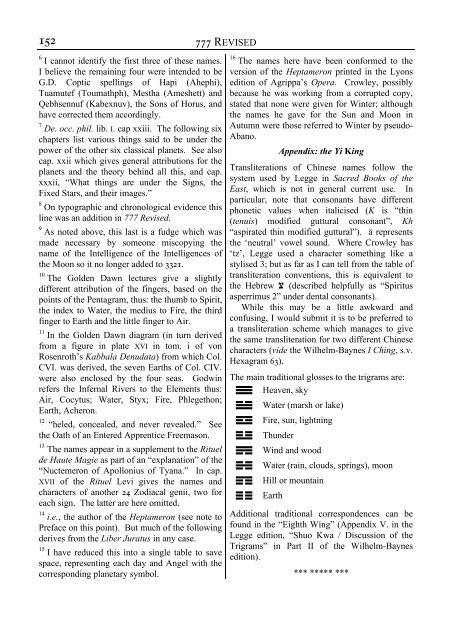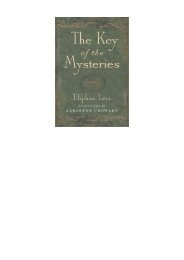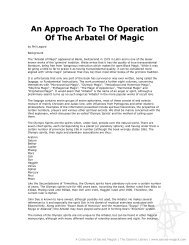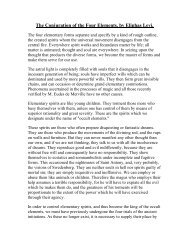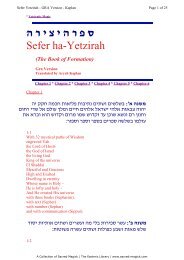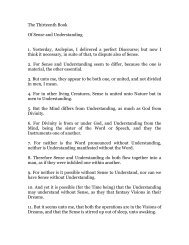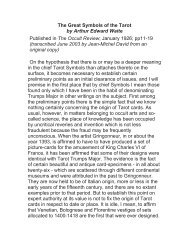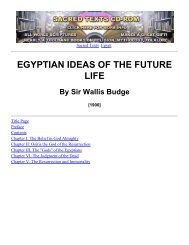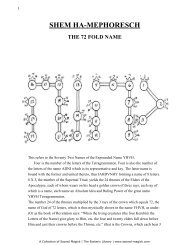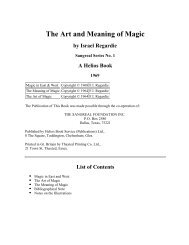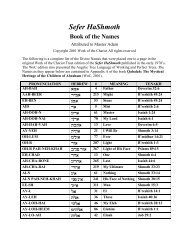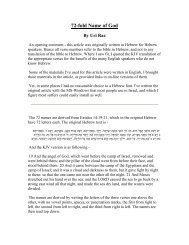Liber 777 (revised) (pdf) - Holy Order of the Golden Dawn Canada
Liber 777 (revised) (pdf) - Holy Order of the Golden Dawn Canada
Liber 777 (revised) (pdf) - Holy Order of the Golden Dawn Canada
Create successful ePaper yourself
Turn your PDF publications into a flip-book with our unique Google optimized e-Paper software.
152<br />
<strong>777</strong> REVISED<br />
6<br />
I cannot identify <strong>the</strong> first three <strong>of</strong> <strong>the</strong>se names.<br />
I believe <strong>the</strong> remaining four were intended to be<br />
G.D. Coptic spellings <strong>of</strong> Hapi (Ahephi),<br />
Tuamutef (Toumathph), Mestha (Ameshett) and<br />
Qebhsennuf (Kabexnuv), <strong>the</strong> Sons <strong>of</strong> Horus, and<br />
have corrected <strong>the</strong>m accordingly.<br />
7<br />
De. occ. phil. lib. I. cap xxiii. The following six<br />
chapters list various things said to be under <strong>the</strong><br />
power <strong>of</strong> <strong>the</strong> o<strong>the</strong>r six classical planets. See also<br />
cap. xxii which gives general attributions for <strong>the</strong><br />
planets and <strong>the</strong> <strong>the</strong>ory behind all this, and cap.<br />
xxxii, “What things are under <strong>the</strong> Signs, <strong>the</strong><br />
Fixed Stars, and <strong>the</strong>ir images.”<br />
8<br />
On typographic and chronological evidence this<br />
line was an addition in <strong>777</strong> Revised.<br />
9 As noted above, this last is a fudge which was<br />
made necessary by someone miscopying <strong>the</strong><br />
name <strong>of</strong> <strong>the</strong> Intelligence <strong>of</strong> <strong>the</strong> Intelligences <strong>of</strong><br />
<strong>the</strong> Moon so it no longer added to 3321.<br />
10<br />
The <strong>Golden</strong> <strong>Dawn</strong> lectures give a slightly<br />
different attribution <strong>of</strong> <strong>the</strong> fingers, based on <strong>the</strong><br />
points <strong>of</strong> <strong>the</strong> Pentagram, thus: <strong>the</strong> thumb to Spirit,<br />
<strong>the</strong> index to Water, <strong>the</strong> medius to Fire, <strong>the</strong> third<br />
finger to Earth and <strong>the</strong> little finger to Air.<br />
11<br />
In <strong>the</strong> <strong>Golden</strong> <strong>Dawn</strong> diagram (in turn derived<br />
from a figure in plate XVI in tom. i <strong>of</strong> von<br />
Rosenroth’s Kabbala Denudata) from which Col.<br />
CVI. was derived, <strong>the</strong> seven Earths <strong>of</strong> Col. CIV.<br />
were also enclosed by <strong>the</strong> four seas. Godwin<br />
refers <strong>the</strong> Infernal Rivers to <strong>the</strong> Elements thus:<br />
Air, Cocytus; Water, Styx; Fire, Phlegethon;<br />
Earth, Acheron.<br />
12<br />
“heled, concealed, and never revealed.” See<br />
<strong>the</strong> Oath <strong>of</strong> an Entered Apprentice Freemason.<br />
13<br />
The names appear in a supplement to <strong>the</strong> Rituel<br />
de Haute Magie as part <strong>of</strong> an “explanation” <strong>of</strong> <strong>the</strong><br />
“Nuctemeron <strong>of</strong> Apollonius <strong>of</strong> Tyana.” In cap.<br />
XVII <strong>of</strong> <strong>the</strong> Rituel Levi gives <strong>the</strong> names and<br />
characters <strong>of</strong> ano<strong>the</strong>r 24 Zodiacal genii, two for<br />
each sign. The latter are here omitted.<br />
14<br />
i.e., <strong>the</strong> author <strong>of</strong> <strong>the</strong> Heptameron (see note to<br />
Preface on this point). But much <strong>of</strong> <strong>the</strong> following<br />
derives from <strong>the</strong> <strong>Liber</strong> Juratus in any case.<br />
15 I have reduced this into a single table to save<br />
space, representing each day and Angel with <strong>the</strong><br />
corresponding planetary symbol.<br />
16 The names here have been conformed to <strong>the</strong><br />
version <strong>of</strong> <strong>the</strong> Heptameron printed in <strong>the</strong> Lyons<br />
edition <strong>of</strong> Agrippa’s Opera. Crowley, possibly<br />
because he was working from a corrupted copy,<br />
stated that none were given for Winter; although<br />
<strong>the</strong> names he gave for <strong>the</strong> Sun and Moon in<br />
Autumn were those referred to Winter by pseudo-<br />
Abano.<br />
Appendix: <strong>the</strong> Yi King<br />
Transliterations <strong>of</strong> Chinese names follow <strong>the</strong><br />
system used by Legge in Sacred Books <strong>of</strong> <strong>the</strong><br />
East, which is not in general current use. In<br />
particular, note that consonants have different<br />
phonetic values when italicised (K is “thin<br />
(tenuis) modified guttural consonant”, Kh<br />
“aspirated thin modified guttural”). b represents<br />
<strong>the</strong> ‘neutral’ vowel sound. Where Crowley has<br />
‘tz’, Legge used a character something like a<br />
stylised 3; but as far as I can tell from <strong>the</strong> table <strong>of</strong><br />
transliteration conventions, this is equivalent to<br />
<strong>the</strong> Hebrew x (described helpfully as “Spiritus<br />
asperrimus 2” under dental consonants).<br />
While this may be a little awkward and<br />
confusing, I would submit it is to be preferred to<br />
a transliteration scheme which manages to give<br />
<strong>the</strong> same transliteration for two different Chinese<br />
characters (vide <strong>the</strong> Wilhelm-Baynes I Ching, s.v.<br />
Hexagram 63).<br />
The main traditional glosses to <strong>the</strong> trigrams are:<br />
7 Heaven, sky<br />
6 Water (marsh or lake)<br />
5 Fire, sun, lightning<br />
4 Thunder<br />
3 Wind and wood<br />
2 Water (rain, clouds, springs), moon<br />
1 Hill or mountain<br />
0 Earth<br />
Additional traditional correspondences can be<br />
found in <strong>the</strong> “Eighth Wing” (Appendix V. in <strong>the</strong><br />
Legge edition, “Shuo Kwa / Discussion <strong>of</strong> <strong>the</strong><br />
Trigrams” in Part II <strong>of</strong> <strong>the</strong> Wilhelm-Baynes<br />
edition).<br />
*** ***** ***


